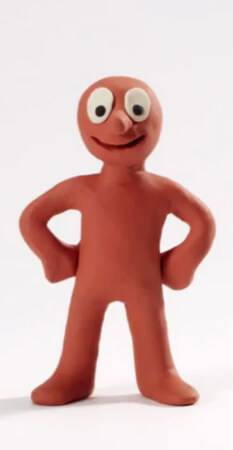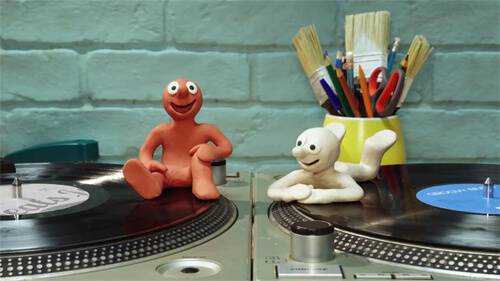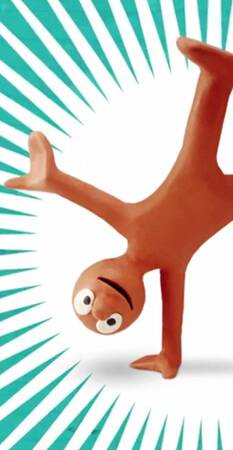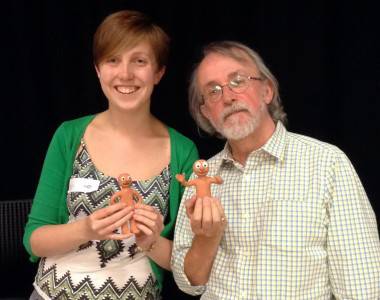Morph Returns! Q&A with Peter Lord & David Sproxton
 Thirty-seven years after he first appeared on our screens, Morph is finally back with a slight difference; He’s coming to us via YouTube! After a successfully funded Kickstarter campaign, we have an all-new fifteen-part series of one-minute episodes featuring Morph and of course, his sidekick Chas. In the Kickstarter spirit Peter Lord and David Sproxton – Morph’s creators – along with Merlin Crossingham, director of the new series, wanted to create a sense of community with the audience and invited suggestions for themes and gags for the episodes as well as putting together a series of “making-of” episodes so we can see just how they’ve brought Morph back to life.
Thirty-seven years after he first appeared on our screens, Morph is finally back with a slight difference; He’s coming to us via YouTube! After a successfully funded Kickstarter campaign, we have an all-new fifteen-part series of one-minute episodes featuring Morph and of course, his sidekick Chas. In the Kickstarter spirit Peter Lord and David Sproxton – Morph’s creators – along with Merlin Crossingham, director of the new series, wanted to create a sense of community with the audience and invited suggestions for themes and gags for the episodes as well as putting together a series of “making-of” episodes so we can see just how they’ve brought Morph back to life.
The first episode of the new Morph series was aired on Friday at 17:15, the exact time of Morph’s first ever TV appearance during Take Hart, broadcast on BBC1 on 15th February 1977. Skwigly were delighted to be invited to Google HQ in London on Friday to talk to Peter Lord and David Sproxton about Morph’s return after all these years, and even take a stab at making a Morph of our own…
Congratulations! It’s been a long haul but the premiere has arrived! How are you feeling having Morph back after all this time?
Lord: Delighted! So happy, it’s just great! It’ been a lovely thing and although you say it’s been a long haul, relatively speaking it’s been a breeze actually. It feels like it’s been spontaneous, it feels to me like we had the idea – and it was a good idea – to bring him back and then everything fell into place really sweetly and easily. And the Kickstarter campaign… that was fun too.
It’s been a very short period of time between finishing the Kickstarter campaign and the actual release, hasn’t it?
Sproxton: I think the whole thing has taken about a year. I think when we launched Kickstarter it was around this time of year…
Lord: Probably, the Kickstarter idea was maybe a year ago…
Sproxton: Yeah, the Kickstarter thing was in October – something like that – and then we planned to go into production if it all came into fruition early in the new year, which we did – in January – so it’s taken about six months to get the fifteen episodes.
How long was the idea of bringing Morph back kicking around before you actually started the Kickstarter?
Sproxton: Oddly enough, we’ve been wanting to do it for years, and having the opportunity… The TV bit doesn’t work for really short format anymore. That was the problem with getting him back onto screens with TV modern not doing what it used to do so, that is to say, he used to be a side of our show. So we thought Kickstarter was the way to go, or at least YouTube was the way to go.
Was deciding to go with YouTube a difficult decision to make?
Sproxton: Well, fundamentally we thought, what have we got to lose? If it doesn’t work then we’re no worse off, if it does work, great, we’ll launch more!
So that’s the plan if it goes well? Another series?
Lord: I’d love to keep doing short films like this, because it’s great for him – it’s great for Morph – and it’s actually really good for the studio, you know? People really enjoy doing these short films and I like the idea that production can be light on it’s feet and not – you know – not too cumbersome – nearly spontaneous. You know, you may say that a month to make one film isn’t very spontaneous, but believe me it’s pretty good going.

Morph and Chas in their first new adventure Twin Decks
It’s pretty spontaneous, yes! I suppose the public also really enjoyed being able to contribute and send you their ideas?
Lord: Yeah, that’s been great.
Sproxton: Yeah, the feedback’s been fantastic and in the age of – you know – old-style television, you would only know how many people watched it; you didn’t know who they were. It’s a real community, which has been fantastic.
How many of the ideas for the fifteen shorts were ideas from the public and how many were ideas from the studio?
Lord: One was very specific from the public, only one, but three or four more you could say there was clear input from the public. In some cases, for example, we’ve got one with a gag with a Smartphone, which we worked up together. A number of people suggested that. People would say, ‘Hey! Morph with a Smartphone’, so it’s over to us to think of the story. So quite a lot of impact really.
So did a lot of these ideas come to you as very simple ideas, not completed scripts?
Sproxton: It was often just a set-up – no ideas saying ‘exactly like that’.
Lord: That’s how we like to work, but that’s how we always have worked. You literally think of an idea… you know… ‘Ice skating’… I don’t know… ‘Parachuting’… anything, and you think, ok, that’s the idea, now what would Morph do? And then, finding a story is not so easy actually; it takes time and craft.
So you were working with Merlin on the stories and directing. Were there any cases where he said ‘oh this is it’ and you went ‘no, Morph would not do that’?
Lord: While you’re getting there, having got the first idea, to get to the polished version of the story there’s quite a lot of that happens. You know, that’s not quite right…
Sproxton: It’s an evolution process, isn’t it? You have the idea and you gradually hone it to get to the final piece but there’s a lot of – you know, we do storyboards and animatics – and there’s a lot of work that goes on into those to get it finessed having had the initial idea. It did… It’s quite difficult to describe if you haven’t been part of it to see the way in which you just gradually work and work and work to get it to where you want it. Sometimes they are instant – sometimes you think, ‘great, that’s fantastic to do’.
Lord: And some of these suggestions, our backers, I think two suggested Morph jousting would be good, and we spent a lot of time on that. We sat around together but we couldn’t make it work. Maybe another day we will. Maybe another day we’ll find the story that goes with the idea, because yes, that sounds like a fun thing to do but we couldn’t find it, so we spent some hours not finding it. That’s the way it works.
So it was all a fairly fluid process from story to completion. It all happened very quickly.
Lord: It was relatively quick – energetic because it’s quick – which is nice. Not too many voices, which is nice and because it was all our decision which was great. We are the higher-ups, which is great – we didn’t have to talk to any studio.
How do you feel the production differed from, say, Wallace and Gromit or Shaun the Sheep?
Sproxton: Well, it’s much lighter on it’s feet. It’s a smaller thing. You’re only doing one-minute episodes so the writing is quicker. And not having, in a way, the ‘higher ups’, which tend to be commissioning editors, saying ‘well actually the script doesn’t quite work for making this, can you do that?’ that tends to be on those… because you know, they’ve invested a lot of money in say a 20 or 40-part series and they want it to play to their station brand. And of course they’re one of the many stations that are going to be putting out across the world. And of course that slows down the process. ‘Oh I don’t like the way he does this…’
So by being in partnership with the public, as opposed to the BBC or Sony, you have a lot more creative freedom?
Lord: The things like – in Wallace and Gromit particularly – the camera moves quite a lot, and that’s fun but it really, really slows you down. We just set up ourselves some limits, like, the camera wouldn’t move – the characters move but not the camera – and it’s all done on one set. That’s how we’ve always done it anyway, so we made a virtue of that and kept it simple, kept it light.
 So the style of Morph’s animation is the same as it always was?
So the style of Morph’s animation is the same as it always was?
Lord: The style’s the same, though the interesting thing is that you have new animators on it and new animators always find – hopefully find – something new; some little, subtle thing that’s different and delightful and that I never would have thought of back in the day. So that’s good.
So in that way, Morph is evolving?
Lord: Yeah.
Would you say he’s been modernised at all? You mentioned the Smartphone before but in any other ways?
Lord: I don’t see it very much. No, not in the way he moves…
Sproxton: As a character he is the same because that works and that relationship with Chas works. A more modern world, more modern props, it’s shot in a very different and modern way – the films are shot digitally – so that enhances it and actually makes it quicker and easier, but the fundamentals of the character, the crafted nature of the animations is exactly the same.
Lord: And he’s doing some things he’s never done before, I suppose that’s true. He’s doing a stand-up routine this time. That’s a new area for him.
What’s the schedule for releasing the episodes?
Sproxton: One every two weeks and new videos going in-between. There’s other footage; there’s making-of stuff.
So what’s going in the making-of episodes? How long are they?
Sproxton: They’re a couple of minutes – they snip down into nice little chunks of about a couple of minutes each so you get to see different aspects of the process.
So is that to hopefully try to inspire more people to try stop motion out?
Lord: It’s part of the same spirit as the Kickstarter campaign and being on YouTube. It’s inclusivity, you know; it’s taking people behind the scenes so they can see the individuals – because when we did it back in the day no one knew who we were and we didn’t get any credit – and so it’s a way of letting some of the people who made the films get some credit, make it personal. And yes, I hope also to keep repeating the message that this is accessible for people, for the general public. It’s so much more accessible than when we first started. When we started working on film, animating on film was a pretty unusual and now so many people have got phones and laptops and so on…
For this series you’ve returned to traditional claymation, which is where you started…
Sproxton: Because it’s so much been at the heart of the company all these years… Morph has had various outings across the years and he is a character we use for training animators because he is a really good thing to be trained on; it’s quite tricky to do well. So Morph’s always been there, he just hasn’t been exposed to the public as much and so it’s fantastic to get down to those roots.

Peter Lord and Skwigly writer Julia Young with their Morphs
That’s great. One final question, as we’re now into University Graduation season; if you had a time machine right now and could go back and talk to yourselves just graduated from university, what’s the one piece of advice you would give to them?
Lord: Holy cow…
Sproxton: Sort of…Follow your passions actually. That’s kind of what we did, you know. There were a few years when we were almost… not quite skint… we didn’t make a lot of money in the early days on Morph at all or the early work we did for years in many ways. But we kind of stuck it out and got better at it. It’s harder these days because… well… employment… jobs… that kind of stuff is harder but I think if you do what you really believe in then stuff will work out… that’s probably it… and in this sort of industry if you want to get good then keep practicing is the other big thing, whatever you do.
Lord: I think that’s almost exactly what I’d say. It’s that thing of doing what you do and doing it for – and this is going to sound very pompous – but for the right motives. To me, fulfilling yourself creatively is a really valuable thing to do and doing stuff to entertain people… I mean… Do it because you love it… I mean, we’re of the generation where you did what you love and we didn’t set out to make money. Dave said we didn’t have money – and that’s true – but that was never the point; the point was to make good films and anything else followed and I think that’s quite a healthy approach to life personally!
The new series and the accompanying “making-of” videos will be available at www.youtube.com/MorphOfficial. Subscribe to the channel to be notified of new videos and visit Morph’s Facebook, Instagram and Twitter. Also while you’re on twitter, check out the hastag #MorphIsBack and if you have a Morph at home, take a #Morphie – a selfie with you and Morph! We hear there might be some prizes for the best ones!

